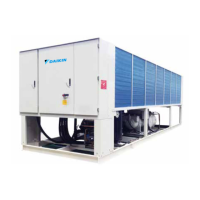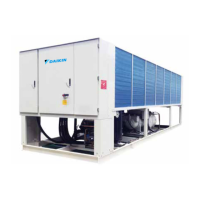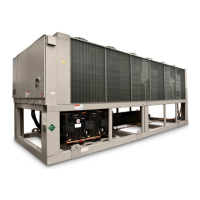33
Water Processing Method
To ensure effective operation and durability, cleaning, washing and chemical processing are very important for
water systems. Different types of water circuits need to be cleaned in different ways.
■ Close Re-Circulation System
Water systems of this type generally require no adjustment to subdue scale, and require no chemical to
suppress mud and alga. This type of water system is recommended. Closed recycle systems may need anti-
corrosion measures, including the following (for reference only):
NaNO
2
, borate and inhibitors for organic materials
a. NaNO
2
, borate and silicate
b. High density chromate solution and pH control
c. pH and sulte control
d. Polyphosphate salt and silicate
e. Alkali, phosphate and sulte control
Because it is hard to control water quality, for closed recycle systems, we recommend that the total density of
copper pipe inhibitors such as NaNO
2
, borax, silicate and benzothiazole should be no less than 1400 ppm. The
inhibitor NaNO
2
is soluble in glycol, and can be used in northern areas or in the subsystem of solar power systems.
■ Open Re-circulation System
This type of water system is generally not recommended. They are exposed to the atmosphere, and are
susceptible to scale, corrosion, mud and alga. Therefore, they might degrade the performance and reduce the
service life of the unit.
■ Once-through System
Generally, once-through systems are only used for cooling only air conditioners. Water systems of this type use
water from taps, lakes, rivers, and wells. Although the once-through system exchanges heat with the closed
water circuit, it is not considered as an integral part of the water source heat pump system. Once-through
systems may be troubled by either scale or corrosion. This type of water system requires large amount of
adjustment water. Therefore, you need to consider the scale coefcient, the equipment used for cleaning work,
and necessary anti-corrosion materials.
Caution
Water from lakes and rivers may cause problems such as mud and alga!
Comparison among closed recycle systems, open recycle systems and once-through systems
Once-through System Open Recycle System Closed Recycle System
Scale control
1. Surface activator such as
polyphosphate salt
2. Increased acidity
3. pH adjustment
4. Other considerations include:
surface temperature, water
temperature and system cleaning
1. Discharge
2. Surface activator such as
polyphosphate salt
3. Increased acidity
4. pH adjustment
5. Softening (other considerations
include: surface temperature, water
temperature and system cleaning).
No control is necessary
Corrosion control
1. Low density corrosion inhibitor
2. Anti-CaCO
2
plate
3. pH control
4. Proper material
1. High density (200 - 500 ppm)
corrosion inhibitor
2. Low density (20 - 30 ppm)
corrosion inhibitor
3. pH control
4. Proper material
1. High density corrosion inhibitor
2. Proper material
Mud and alga control
1. Chloridized hydroxybenzene
2. Other chemicals
3. Chlorine formed by hypochlorite
and liquid chlorine
1. Chloridized hydroxybenzene
2. Other chemicals
3. Chlorine formed by hypochlorite
and liquid chlorine
No control is necessary

